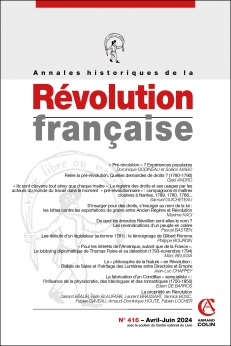
ANNALES HISTORIQUES DE LA RÉVOLUTION FRANÇAISE Nº416 (2/2024)
Pour acheter ce numéro, contactez-nous
Recevez les numéros de l'année en cours et accédez à l'intégralité des articles en ligne.
En février et mars 1792 éclate, dans l’arrière-pays dunkerquois, un vaste mouvement insurrectionnel contre les exportations de grains à l’étranger par voie maritime. Ce mouvement s’inscrit dans le prolongement des actions protestataires contre les départs des productions locales par le port de Dunkerque qui jalonnent la seconde moitié du XVIIIe siècle. La situation frontalière et le paysage social qui structurent l’arrière-pays dunkerquois forment un élément de continuité qui explique la persistance d’un mécontentement collectif. Toutefois, dans les propos comme dans les actions des émeutiers, plusieurs évolutions significatives s’affirment progressivement. La nouvelle grammaire politique qui, à partir de 1789, couronne la volonté nationale et la citoyenneté, est appropriée localement. Progressivement, les émeutes frumentaires ne sont plus réductibles à une « économie morale de la foule » ancrée dans des pratiques communautaires traditionnelles. Elles semblent exprimer une forme de patriotisme social qui se fonde sur la conviction collective que la prise en charge par les citoyens eux-mêmes de l’application des lois nouvelles doit permettre de subvenir aux besoins de tout un chacun. La revendication du droit à l’existence est ainsi adaptée à une conjoncture politique nouvelle. Les interactions entre les protestataires, les autorités locales et l’Assemblée finissent par donner un retentissement national aux revendications collectives.
In February and March 1792, in the hinterland of Dunkirk, a vast insurrectionary movement broke out against the export of grain abroad by sea. This movement was part of a series of protests against the departure of local produce by the port of Dunkirk in the second half of the eighteenth century. The border situation and the social landscape that structure theDunkirk hinterland form an element of continuity which explains the persistence of collective discontent. Yet a number of significant changes were gradually taking place both in the words and actions of the rioters. The new political grammar that from 1789 onwards crowned the national will and citizenship was being appropriated locally. Gradually, the riots could no longer be reduced to a "moral economy of the crowd" rooted in traditional community practices; they appeared to express a form of social patriotism founded on the collective conviction that if citizens themselves took responsibility for applying the new laws, they would meet everyone’s needs. The demand for the right to exist was thus adapted to a new political conjuncture. Interactions between protesters, local authorities, and the Assembly eventually gave the collective demands a national resonance.